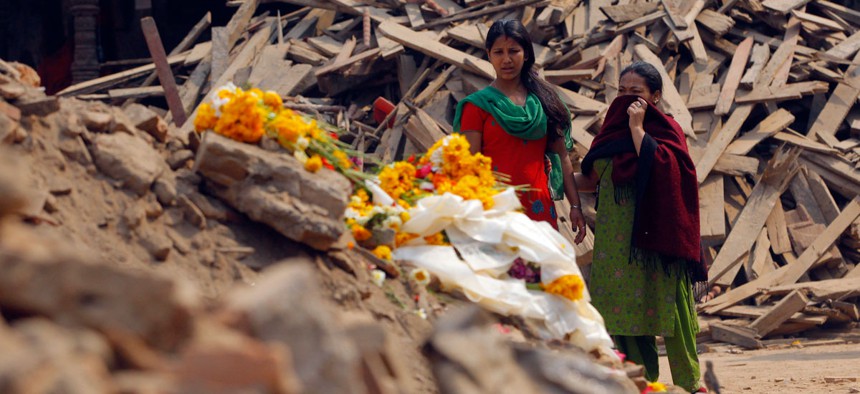How Social Media Is Helping Nepal Rebuild After Two Big Earthquakes

Nepalese women look at floral tributes placed in memory of victims killed in the earthquake, at Basantapur Durbar Square in Kathmandu, Nepal, Thursday, May 7, 2015. Niranjan Shrestha/AP
With little disaster infrastructure in place, groups of Nepalis, foreign aid workers and academics, and the country’s diaspora, moved swiftly to organize an Internet-driven response to the disasters.
After the earthquake struck Nepal on April 25, killing over 8,000 people and leaving more than 250,000 homeless, the small Himalayan nation—among the poorest in world—was left scrambling to respond. And with little disaster infrastructure in place, groups of Nepalis, foreign aid workers and academics, and the country’s diaspora, moved swiftly to organise an internet-driven response. That effort is still ongoing.
In the immediate aftermath of the first earthquake, social media sputtered with sporadic safety reports and concerns. Facebook activated its Safety Check feature giving quick safety status updates, but information was initially slow and Nepal’s political leadership largely quiet.
After two days or so, Facebook and Twitter exploded. Requests for help started inundating social media feeds. “300 people are stranded on the hill opposite last resort,”…. “4000 people in Kavre need tents and blankets,”…”Trapped people badly need food and tents in Sitapaila,”… “Muchchok, Gorkha is devastated, all homes collapsed.”
Saroj Karki, 23, who founded a blood donation group Youth for Blood in 2011, immediately transformed his team into a social media-driven relief vehicle: the Rapid Response Team. He began fielding digital requests from Nepalis—inside and outside the country—who couldn’t contact family and friends due to overwhelmed phone networks. They started a texting app for receiving earthquake updates (still important as large aftershocks continue) and shared it via Facebook.
The team received 300 texts in 36 hours and over 8,500 hits on their site, Karki said. And while they couldn’t keep track of exactly how many calls they received from people searching for friends and family but the team’s made at least 1,000 calls to track people down since the first earthquake.
A similar volunteer group called Sankalpa had been using third-party mobile messaging service, Sparrow SMS, to text urgent blood needs pre-quake. The same technology was converted to a texting app for urgent rescue needs. The text reports, alongside Tweets and Facebook posts, were then compiled into one relief map. Sparrow has received about 1,000 texts, which were made into 350 reports.
Sorting it out
Another mapping exercise was underway at Kathmandu Living Labs, a Kathmandu-based non-profit tech company, which used open data and tools like OpenStreetMap to track all kinds of development issues in Nepal. They, too, swiftly transitioned into relief mode, coordinating a team of volunteers to collect Facebook posts and Tweets into one organized quake map. This was then shared with a clutch of relief groups and the Nepal Army.
Many of the posts were first organized on a Facebook page—Nepal Earthquake Relief Volunteers—created by Barbara Grossman, a 30-year-old American who left Nepal two days before the first earthquake.
Despite jammed networks, many could still post on Facebook, but those on the ground had little capacity to collate and arrange the large amounts of information coming in.
“It became very clear there was just total confusion because of the inability of the cellular networks to handle the traffic,” she explained.
So, Grossman, who just finished a PhD in sociology at UC Boulder, made a page to focus only on relief supply and demand information. Then, she put together a team of administrators—a group of six volunteers from Nepal, the US, and Canada—to help edit and update it.
Three days after the page opened, they had 129 posts that reached some 50,000 people on Facebook. Then, a day later, on April 29, the group coordinated 1,500 tents to Sindhupalchowk and 400 to Dolakha, two of the most severely affected rural districts. Grossman said the page’s posts had reached 200,000 people by May 3.
Making it work
But with just about 40% of the country online, the utility of social media is typically limited outside urban population centres. Still, those in the hinterland can send a text to someone in the city, who can then post it on their Facebook wall, where someone else can post it to a coordination group. Finally, a volunteer can enter it on a relief map.
It may seem like a tenuous chain but it does seem to have worked till the mapping stage. The more difficult part, volunteers agree, is ensuring the physical relief arrives in the areas shown in the maps.
“Crisis mapping,” as it’s termed, gained traction during the 2010 Haiti earthquake, explained Brian Tomaszewski, a professor at the Rochester Institute of Technology who studies mapping technology for disaster relief. “Similar to Nepal you had a huge disaster in a poor developing country and everyone in the world wants to help out,” he said.
And what was a somewhat “free-form” movement five years ago—with individual volunteers mapping without much coordination—has since been refined, and crowdmapping tools like those used by Kathmandu Living Labs and Sankalpa help limit inaccurate reports. But “with any of this crowdsource stuff, it’s an issue of credibility and reliability,” Tomaszewski said.
Then, there is the question of how much impact these groups actually have on the ground. But with Nepal’s government authorities struggling to cope, volunteers like 34-year-old Shitu Rajbhandari, who helps the Kathmandu Living Labs’ project, argue that every little bit counts. Even ensuring that 20 pieces of important supplies like tarps can be procured and delivered.
“It might be a drop in the ocean,” said Rajbhandari, “but it’s still a drop.”
NEXT STORY: President Obama Gets Official Twitter Account



